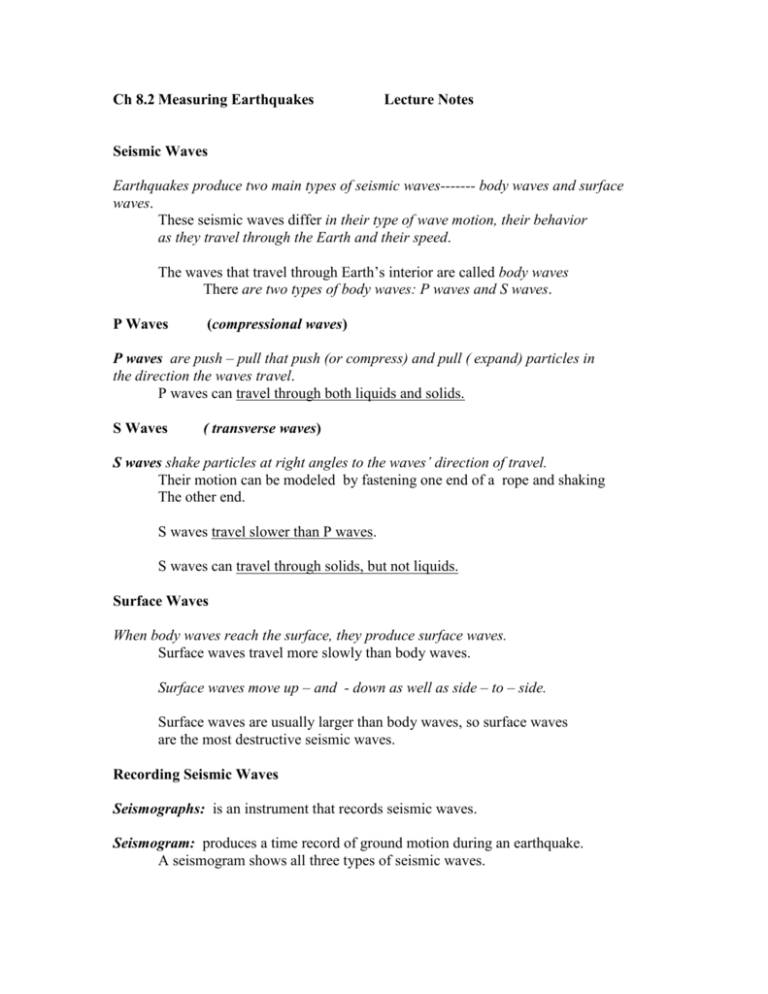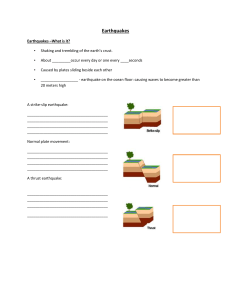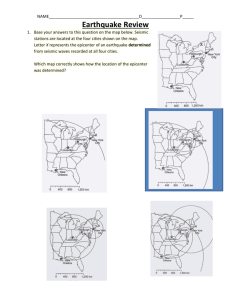File - Mr. Neason`s Earth Science
advertisement

Ch 8.2 Measuring Earthquakes Lecture Notes Seismic Waves Earthquakes produce two main types of seismic waves------- body waves and surface waves. These seismic waves differ in their type of wave motion, their behavior as they travel through the Earth and their speed. The waves that travel through Earth’s interior are called body waves There are two types of body waves: P waves and S waves. P Waves (compressional waves) P waves are push – pull that push (or compress) and pull ( expand) particles in the direction the waves travel. P waves can travel through both liquids and solids. S Waves ( transverse waves) S waves shake particles at right angles to the waves’ direction of travel. Their motion can be modeled by fastening one end of a rope and shaking The other end. S waves travel slower than P waves. S waves can travel through solids, but not liquids. Surface Waves When body waves reach the surface, they produce surface waves. Surface waves travel more slowly than body waves. Surface waves move up – and - down as well as side – to – side. Surface waves are usually larger than body waves, so surface waves are the most destructive seismic waves. Recording Seismic Waves Seismographs: is an instrument that records seismic waves. Seismogram: produces a time record of ground motion during an earthquake. A seismogram shows all three types of seismic waves. Ch 8.2 Measuring Earthquakes Lecture Outline P. 2 The stronger the earthquake, the larger the waves on the seismogram. Measuring Earthquakes Intensity: is a measure of the amount of earthquake shaking at a given location based on the amount of damage. Magnitude: is a measure of the size of seismic waves or the amount of energy released at the source of the earthquake. The Richter scale and the moment magnitude scale measure earthquake magnitude. Richter Scale The Richter scale is based on the height of the largest seismic wave ( P, S, or surface wave) recorded on the seismogram. A ten fold increase is wave height equals an increase of 1 on the magnitude scale. For example: the amount of ground shaking for a M 5.0 is 10 times greater than the shaking produced by an earthquake of M 4.0 on the Richter scale. Seismic waves weaken as the distance between the earthquake focus and the Seismograph increases. The Richter scale is only useful for small, shallow earthquakes within 500 kilometers of the epicenter. Moment Magnitude Moment magnitude is the most widely used measurement of earthquakes because it is the only magnitude scale that estimates the total energy released by earthquakes. The moment magnitude is derived from the amount of displacement that occurs along a fault. The moment magnitude is calculated using several factors in addition to seismograph data. These factors are: 1. the average amount of movement along the fault 2. the area of the surface break 3. the strength of the broken rock Together these factors provide a measure of how much energy rock can store Before it suddenly slips and releases this energy during an earthquake. Ch 8.2 Measuring Earthquakes Lecture Outline P. 3 Modified Mercalli Scale The Modified Mercalle scale rates an earthquake’s intensity in terms of the earthquake’s effect at different location. This scale has 12 steps…with I being the least and XII being the most destruction. Locating an Earthquake The difference in speeds of P and S waves provides a way to locate the epicenter. The P wave arrives first. Then the slow S waves follow behind. The greater the interval between the arrival of the first P wave and the first S wave, the greater the distance to the earthquake epicenter. A travel-time graph data from seismograms made at three or more locations and a globe can be used to determine an earthquake’s epicenter.







